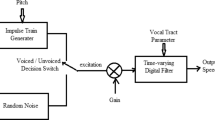Abstract
A novel pitch detection scheme (PDS) based on weighted autocorrelation function (WACF) is proposed. The proposed scheme has been simulated and then integrated in an analysis-synthesis system for speech signal. The simulation and real-time performance comparison of this scheme with two other existing schemes [ACF and weighted ACF (WACF)] has been carried out. The performance comparison results show that the proposed PDS outperforms (in terms of speech quality and intelligibility) for both clean as well as noisy environment as compared to the other conventional PDS schemes considered for the comparison. Moreover, simulation and real-time implementation results show that the time taken for computation and memory consumption for the proposed PDS is less as compared to the weighted ACF based PDS.







Similar content being viewed by others
References
Bhattacharya, S., Singh, S. K., & Abhinav, T. (2012). Performance evaluation of LPC and Cepstral speech coder in simulation and in real-time. In Proceedings of IEEE International Conference on Recent Advances in Information Technology (RAIT) (826–831).
Deller, J. R., Hansen, J. H. L., & Proakis, J. G. (2000). Discrete-time processing of speech signal (pp. 570–579). Hoboken: Wiley.
Fangming, W., & Yip, P. (1991). Cepstral analysis using discrete trignomatric transform. IEEE Transactions Acoustics, Speech, Signal Processing (ASSP),39(2), 538–541.
Han, Z., & Wang, X. (2019). A signal period detection algorithm based on morphological self-complementtary top-hat transform and AMDF. Information,10(1), 1–12.
Hu, Y., & Loizou, P. (2007). Subjective evaluation and comparison of speech enhancement algorithms. Speech Communication,49, 588–601.
Huang, H., & Pan, J. (2006). Speech pitch determination based on Huang-Hilbert transform. Signal Processing,86(4), 792–803.
Kumar, B. (2018). Comparative performance evaluation of MMSE-based speech enhancement techniques through simulation and real-time implementation. International Journal of Speech Technology, Springer.,21(4), 1033–1044.
Kumar, S., Bhattacharya, S., Dhiman, V., & Mohapatra, S. (2013). Performance evaluation of a wavelet-based pitch detection scheme. International Journal of Speech Technology, Springer.,16(4), 431–437.
Kumar, S., Bhattacharya, S., & Patel, P. (2014). A new pitch detection scheme based on ACF and AMDF. In Proceedings of IEEE International Conference on Advanced Communications, Control and Computing Technologies, Ramnathapuram, India (pp. 1235–1240).
Kumar, S., Bhattacharya, S., & Singh, S. K. (2015). Performance evaluation of a ACF-AMDF based pitch detection in real-time. International Journal of Speech Technology, Springer.,18(4), 521–527.
Mohapatra, S., Dhiman, V., Kumar, S., & Bhattacharya, S. (2011). A theoretical Justification for coincidence of wavelet maxima at a particular scale pair in an Event-based pitch detection method, In Proceedings of IEEE International Conference on Devices Communications (ICDeCom), BIT Mesra, Ranchi (India) (pp. 403–406).
Perceptual Evaluation of Speech Quality (PESQ), ITU-T P. 862.
Pirker, G., Wohlmayr, M., Petrik, S., & Pernkopf, F. (2011). A pitch tracking corpus with evaluation on multipitch tracking scenario. Interspeech, 1509–1512.
Plante, F., Ainsworth, William A., & Meyer, Georg F. (1995). A pitch extraction reference database. EUROSPEECH,95, 837–840.
Rabiner, L. R. (1977). On the use of autocorrelation analysis for pitch detection. IEEE Transactions Acoustics,Speech, Signal Processing (ASSP),25(1), 24–33.
Ross, M. J., Shaffer, H. L., Cohen, A., Freudberg, R., & Manley, H. J. (1974). Average magnitude difference function pitch extractor. IEEE Transactions Acoustics, Speech, Signal Processing (ASSP),22(5), 353–362.
Shimamura, T., & Kobayashi, H. (2001). Weighted autocorrelation for pitch extraction of noisy speech. IEEE Transactions on Speech and Audio Processing,9(7), 727–730.
Author information
Authors and Affiliations
Corresponding author
Additional information
Publisher's Note
Springer Nature remains neutral with regard to jurisdictional claims in published maps and institutional affiliations.
Rights and permissions
About this article
Cite this article
Kumar, S. Performance measurement of a novel pitch detection scheme based on weighted autocorrelation for speech signals. Int J Speech Technol 22, 885–892 (2019). https://doi.org/10.1007/s10772-019-09634-5
Received:
Accepted:
Published:
Issue Date:
DOI: https://doi.org/10.1007/s10772-019-09634-5




